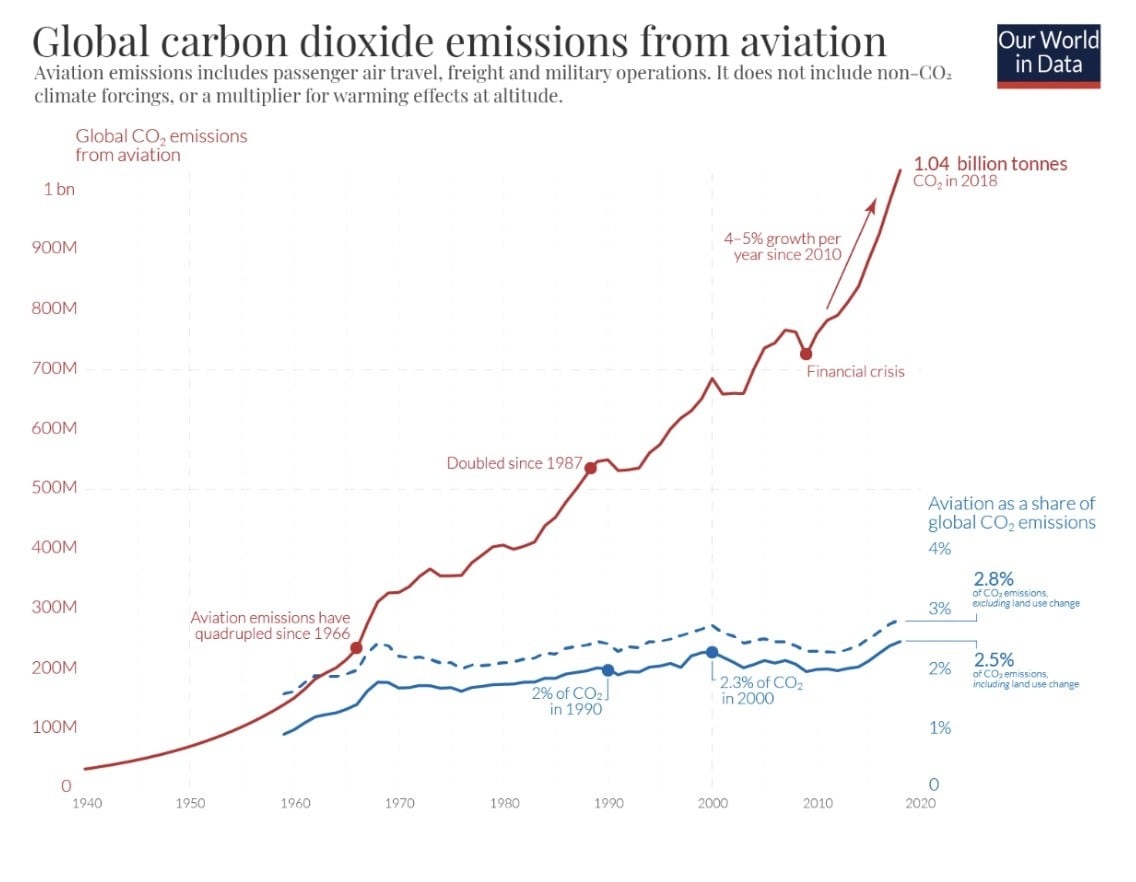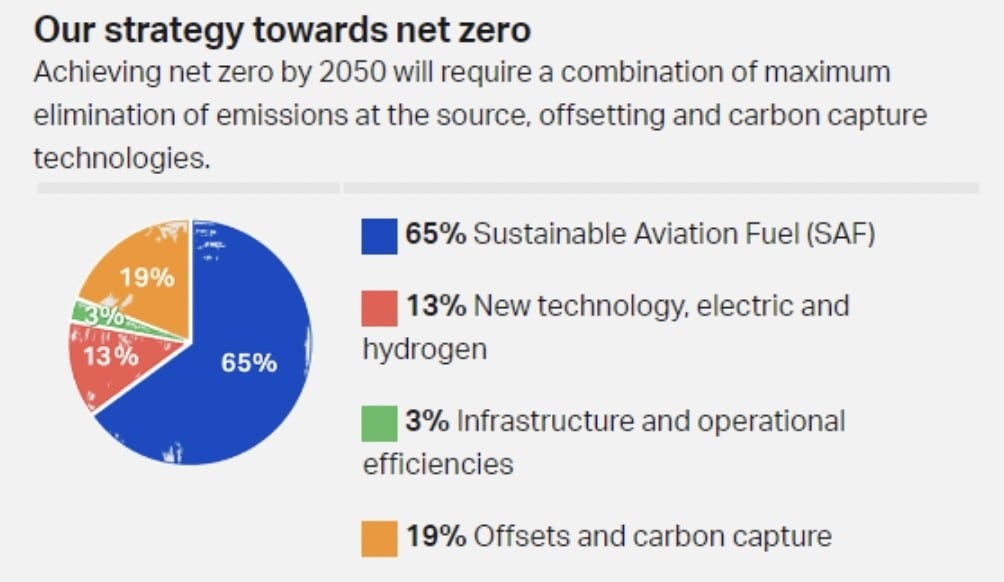The aviation sector wants to reach net zero by 2050. How will it do it?

The global aviation industry has agreed to try to achieve net-zero emissions by 2050.
Image: Unsplash/evadarron
Stay up to date:
Climate Crisis
Listen to the article
- The global aviation industry has agreed to try to achieve net-zero emissions by 2050.
- The airline association IATA says using sustainable fuels and carbon offsetting will contribute more than 80% of the reduction in emissions.
- Other low-emission technologies like electric and hydrogen-powered aircraft are also being developed by major aviation players like Airbus.
For many of us, the ready availability of low-cost air travel has become the norm rather than the exception.
Yet aviation is responsible for around 2.5% of global CO2 emissions, with most aircraft powered by jet gasoline. The European Commission predicts that by the middle of the 21st century, demand for flying could increase aviation’s greenhouse gas emissions by upwards of 300% over 2005 levels if no drastic measures are taken to reduce them.
The aviation industry has adopted the goal of reaching net-zero carbon emissions by 2050. In October, the UN’s International Civil Aviation Organization (ICAO) led two weeks of negotiations involving 184 nations to agree on CO2 emissions reduction measures. These include ramping up innovative aircraft technologies, “streamlining” flight operations and the increased production and use of sustainable aviation fuels (SAF).
“States’ adoption of this new long-term goal for decarbonized air transport, following the similar commitments from industry groups, will contribute importantly to the green innovation and implementation momentum which must be accelerated over the coming decades to ultimately achieve emissions-free powered flight,” said the President of the ICAO Council, Salvatore Sciacchitano.
“As we move from commitment to action, it is essential for the industry to be backed by governments with a decarbonization goal,” said Laia Barbarà, the Industry Decarbonization Lead for Aviation at the World Economic Forum. “ICAO’s Long Term Aspirational Goal (LTAG) of net zero by mid-century is a great step forward in that direction. The World Economic Forum stands ready to support ICAO, governments and the private sector globally as they work on next steps,” she added.
Making aviation fuel more sustainable
Sustainable Aviation Fuels can reduce emissions by 80% according to the International Air Transport Association (IATA). SAF can be made from several sources ranging from agricultural waste to carbon captured from the air.
It is fully compatible with existing aircraft and fueling infrastructure. However, high production costs and limited supply has slowed its adoption. It is estimated that SAF comprises less than 0.1% of all jet fuel currently used.
IATA estimates that SAF could make up around 65% of the emissions reduction needed by aviation to reach net-zero by 2050. But it says “this will require a massive increase in production in order to meet demand. The largest acceleration is expected in the 2030s as policy support becomes global, SAF becomes competitive with fossil kerosene and credible offsets become scarcer.”
Offsetting emissions from aviation
IATA says the aviation industry won’t be able to completely eliminate emissions at source, and will need to mitigate the rest using a variety of offsetting mechanisms. This is the process where emissions are compensated for by the financing of a reduction in emissions elsewhere.
ICAO adopted the Carbon Offsetting and Reduction Scheme for International Aviation (CORSIA) in 2016, which has been heralded as the first global market-based measure for any sector. IATA says “CORSIA aims to stabilize international civil aviation net CO2 emissions at 2019 levels, from 2021, using offsetting programs.” It adds, “we envisage that as new technology such as SAF becomes widespread, the need for offsets will diminish”.
Electric and hydrogen can also help reduce aviation emissions
With short-haul flights of fewer than 600 miles accounting for more than 17% of airline emissions, new technologies like electric and hydrogen-powered aircraft are also being developed. It’s been estimated that all flights of fewer than 2,500 miles, which make up more than half of all CO2 emissions from aviation, could be electrified or powered by hydrogen.
European aviation giant Airbus is developing three types of hydrogen-fuelled zero-emission commercial aircraft which it says could enter service from 2035. They are: a turboprop plane carrying up to 100 passengers with a range of more than 1,000 nautical miles; a turbofan design (120-200 passengers) with a range of 2,000-plus nautical miles; and a “blended-wing body” design (up to 200 passengers) which could also fly over 2,000 nautical miles.
However, in order for hydrogen to be a carbon-neutral aviation fuel, it will need to be produced using sustainable methods. The ClimateWorks Foundation says “usage of green hydrogen (that is hydrogen produced using additional renewable energy) must be incentivized to achieve the deep decarbonization required from the aviation sector”.
Business and government leaders need to align on a meaningful pathway to accelerate aviation’s decarbonization for more companies to adopt SAF. The Clean Skies for Tomorrow Coalition is a global initiative to facilitate the transition to net-zero flying by 2050 - by accelerating the deployment of sustainable aviation fuel. Co-led by the World Economic Forum, the coalition of more than 100 companies is aiming to power global aviation with 10% SAF by 2030.
How is the World Economic Forum helping to scale vehicle electrification?
Don't miss any update on this topic
Create a free account and access your personalized content collection with our latest publications and analyses.
License and Republishing
World Economic Forum articles may be republished in accordance with the Creative Commons Attribution-NonCommercial-NoDerivatives 4.0 International Public License, and in accordance with our Terms of Use.
The views expressed in this article are those of the author alone and not the World Economic Forum.
Related topics:
Forum Stories newsletter
Bringing you weekly curated insights and analysis on the global issues that matter.
More on Climate ActionSee all
Elizabeth Mills
April 17, 2025
Tom Crowfoot
April 17, 2025
Will Hicks and Louise Thomas
April 16, 2025
Lindsey Ricker and Hanh Nguyen
April 16, 2025
Gill Einhorn
April 15, 2025
Hubert Keller and Maximilian Martin
April 15, 2025








